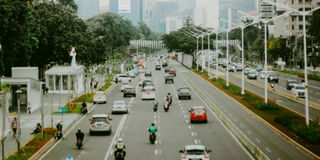Prime
The era of the megalopolis: How the world’s cities are merging

Cities are diminishing, with global digital networks. PHOTO/unsplash.com.
What you need to know:
On the West African coast, meanwhile, the 600km stretch between Abidjan, Ivory Coast and Lagos, in Nigeria, is rapidly catching up. Experts predict that by 2100, this agglomeration of nine cities will be the most densely populated on earth.
On November 15 2022, a baby girl named Vinice Mabansag, born at Dr Jose Fabella Memorial Hospital in Manila, Philippines, became, symbolically, the eight billionth person in the world. Of those eight billion people, 60 percent live in a town or city. By the end of the 21st century, cities will account for 85 percent of Earth’s predicted 10 billion inhabitants. Cities do not only grow by the number of inhabitants. The more people they host, the more services (public transport, energy infrastructure, water supply) they need, the more governance they require and the more resilient their economy has to be. It might be surprising then to learn that there is no single definition of what a city actually is.
In medieval times, cities from London to Seoul were delineated by their walls. And even well into the 20th century, the idea of a city’s limits still held water. Today, if the process of urbanisation still brings to mind the biggest pre-millennial metropolises (Tokyo, São Paulo, New York or Mumbai), they represent nonetheless a decreasing proportion of all the world’s cities.
By contrast, in the more rapidly growing urban centres, such as Lagos, the geographic extent of a mayor’s official jurisdiction often ends long before the populace it serves does. Its economy, meanwhile, is often deeply intertwined with those of the neighbouring cities.
The question of where to draw the line between what is and what is not a city, not to mention where one ends and another begins, is getting harder to answer. As the world moves towards total urbanisation, settlements are spreading out by merging into one another to create what urban experts term “megalopolises”.
How machines saw cities grow
The largest of these mega-cities already exceeds 60 million people. In China, the region of Guangdong province around the Pearl River estuary now known as the Greater Bay Area effectively merges 11 cities, from Macao around to Guangzhou, Shenzhen and Hong Kong.
With a total population of more than 70 million inhabitants, it counts two million more people than the entire population of the UK, squeezed into roughly a fifth of the area. In economic terms, it looms just as large: at US$1.64 trillion (£1.39 trillion) in 2018, its GDP represents 11.6 percent of China’s total.
On the West African coast, meanwhile, the 600km stretch between Abidjan, Ivory Coast and Lagos, in Nigeria, is rapidly catching up. Experts predict that by 2100, this agglomeration of nine cities will be the most densely populated on earth, with up to 500 million people.
Some cities, including Chicago and New York, grew upwards as the technologies of the steel frame and the elevator enabled those with the resources to erect the early skyscrapers, those “cathedrals of commerce”.
With the invention of the automobile, many cities, such as Los Angeles, have grown outwards, despite widespread resistance to the idea of urban sprawl. Some large cities in the developing world including Dar es Salaam in Tanzania or Nairobi in Kenya have grown inwards.
Metaverse
The traditional concept of a city is evolving. Despite our reliance on internal combustion engines for commuting, advancements in computers and networked communications have blurred geographical boundaries. As a result, cities are no longer just defined by their physical size or population; they are increasingly shaped by digital connections and interactions. Historian Lewis Mumford noted in 1937 that cities are not merely physical entities but are defined by social interactions.
This article was first published by theconversation.com.





